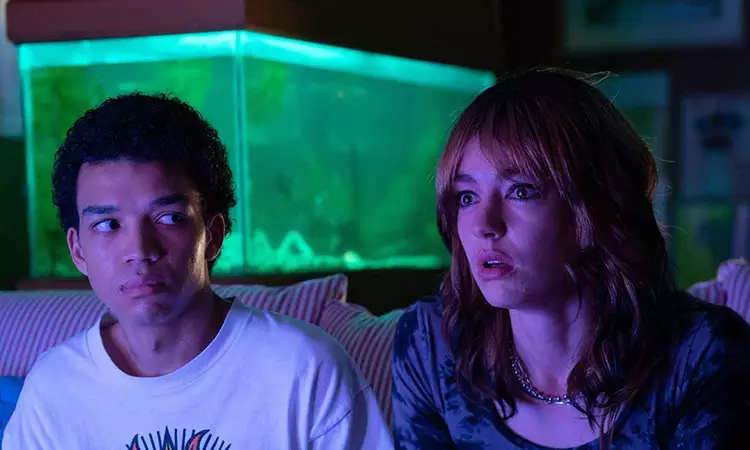In contemporary culture, few experiences rival the gripping allure of media that resonates deeply with its audience. It sparks an obsession that transcends mere entertainment, creating a profound connection with viewers, often at the expense of their emotional and psychological well-being. This phenomenon is encapsulated perfectly in Jane Shoenbrun’s film, “I Saw The TV Glow,” a narrative that dives headfirst into the realm of fanaticism surrounding a fictional show—”The Pink Opaque.” The film expertly navigates the psychological terrain of its young protagonists, Maddy and Owen, reflecting on how a simple television series can morph into a lifeline and, conversely, a source of emotional turmoil.
The core of “I Saw The TV Glow” revolves around the complicated relationship between Maddy, played by Brigette Lundy-Paine, and a young boy named Owen, who is first portrayed by Ian Foreman and later by Justice Smith. Their shared obsession with “The Pink Opaque,” a horror-fantasy spectacle featuring different monsters, serves as a prominent plot device. Maddy, already enmeshed in a web of fandom, introduces Owen to the series. For him, the show becomes an escape, a needed distraction from a world dominated by the constraints imposed by his overbearing parents. This dynamic showcases a common theme: the inclination to seek solace in art amidst the tumult of reality. However, as Owen’s fascination deepens and Maddy attempts to sever her ties with the show, the audience is drawn into a complex exploration of dependency and the fragility of identity.
What sets “I Saw The TV Glow” apart is its subtle but gripping portrayal of horror—not through gore or shocking visuals, but through the psychological struggles of its characters. The titular show, with its ominous antagonist Mr. Melancholy, serves as a reflection of the characters’ inner demons. The film leans into the reality that true horror often emanates from a sense of profound alienation and isolation, particularly evident in Maddy’s disappearance as she tries to free herself from the clutches of obsession. This theme resonates with anyone who has ever felt the sting of being an outsider, whether in fandom, social contexts, or even personal relationships. The film underscores the idea that the monsters we face are oftentimes manifestations of our innermost fears—those that cannot be seen but are felt deeply.
“I Saw The TV Glow” thrives on its ability to evoke a spectrum of responses from its audience. The film cleverly weaves a narrative that prompts viewers to reflect on their own encounters with obsession, media, and identity. Critics and audiences have both praised the film for its intricate layers, emphasizing that no two experiences will mirror one another. This multiplicity of interpretation not only reinforces the film’s artistic merit but invites conversations about the personal and societal implications of media consumption. What does it mean to be consumed by something that should simply be a form of entertainment? In drawing these connections, the film incites discussions about modern escapism and its consequences.
The film does not merely serve as an exploration of Maddy and Owen’s relationship but as a broader commentary on contemporary media culture. In a time where audiences are inundated with content, often cultivating unhealthy obsessions with characters and narratives, “I Saw The TV Glow” raises significant questions about our dependency on art for solace and identity formation. The gripping nature of Maddy and Owen’s fixation serves as cautionary tale—while art has the power to connect and heal, it also has the potential to consume and distort our sense of self.
“I Saw The TV Glow” is not without its dissenting opinions, as such complex narrative approaches often leave some viewers unsettled. Yet, the film’s unique blend of horror and reflection stands as a compelling exploration of the fine line between passion and obsession. With its premiere met with accolades at prestigious festivals like Berlin and SXSW, it’s clear that the film leaves an indelible mark. As audiences prepare to engage with its disturbing themes, they are reminded of a harsh truth: obsession can both inspire creativity and ignite chaos. In this gripping tale, Jane Shoenbrun challenges viewers to confront their own obsessions, inviting them to find meaning in the madness and perhaps discover their true self in the process.

